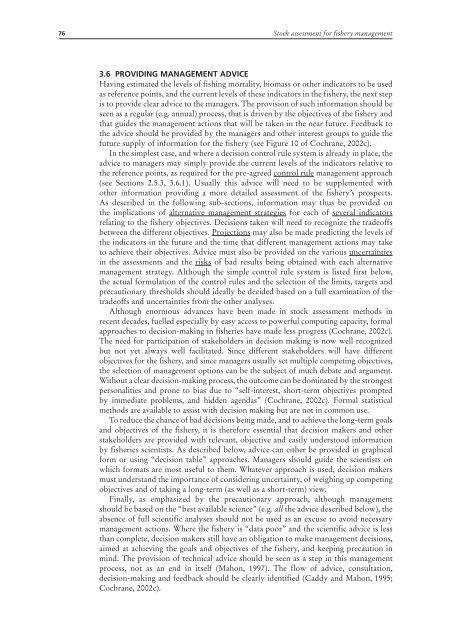Stock assessment for fishery management - Library
Stock assessment for fishery management - Library
Stock assessment for fishery management - Library
Create successful ePaper yourself
Turn your PDF publications into a flip-book with our unique Google optimized e-Paper software.
76 <strong>Stock</strong> <strong>assessment</strong> <strong>for</strong> <strong>fishery</strong> <strong>management</strong>3.6 Providing <strong>management</strong> adviceHaving estimated the levels of fishing mortality, biomass or other indicators to be usedas reference points, and the current levels of these indicators in the <strong>fishery</strong>, the next stepis to provide clear advice to the managers. The provision of such in<strong>for</strong>mation should beseen as a regular (e.g. annual) process, that is driven by the objectives of the <strong>fishery</strong> andthat guides the <strong>management</strong> actions that will be taken in the near future. Feedback tothe advice should be provided by the managers and other interest groups to guide thefuture supply of in<strong>for</strong>mation <strong>for</strong> the <strong>fishery</strong> (see Figure 10 of Cochrane, 2002c).In the simplest case, and where a decision control rule system is already in place, theadvice to managers may simply provide the current levels of the indicators relative tothe reference points, as required <strong>for</strong> the pre-agreed control rule <strong>management</strong> approach(see Sections 2.5.3, 3.6.1). Usually this advice will need to be supplemented withother in<strong>for</strong>mation providing a more detailed <strong>assessment</strong> of the <strong>fishery</strong>’s prospects.As described in the following sub-sections, in<strong>for</strong>mation may thus be provided onthe implications of alternative <strong>management</strong> strategies <strong>for</strong> each of several indicatorsrelating to the <strong>fishery</strong> objectives. Decisions taken will need to recognize the tradeoffsbetween the different objectives. Projections may also be made predicting the levels ofthe indicators in the future and the time that different <strong>management</strong> actions may taketo achieve their objectives. Advice must also be provided on the various uncertaintiesin the <strong>assessment</strong>s and the risks of bad results being obtained with each alternative<strong>management</strong> strategy. Although the simple control rule system is listed first below,the actual <strong>for</strong>mulation of the control rules and the selection of the limits, targets andprecautionary thresholds should ideally be decided based on a full examination of thetradeoffs and uncertainties from the other analyses.Although enormous advances have been made in stock <strong>assessment</strong> methods inrecent decades, fuelled especially by easy access to powerful computing capacity, <strong>for</strong>malapproaches to decision-making in fisheries have made less progress (Cochrane, 2002c).The need <strong>for</strong> participation of stakeholders in decision making is now well recognizedbut not yet always well facilitated. Since different stakeholders will have differentobjectives <strong>for</strong> the <strong>fishery</strong>, and since managers usually set multiple competing objectives,the selection of <strong>management</strong> options can be the subject of much debate and argument.Without a clear decision-making process, the outcome can be dominated by the strongestpersonalities and prone to bias due to “self-interest, short-term objectives promptedby immediate problems, and hidden agendas” (Cochrane, 2002c). Formal statisticalmethods are available to assist with decision making but are not in common use.To reduce the chance of bad decisions being made, and to achieve the long-term goalsand objectives of the <strong>fishery</strong>, it is there<strong>for</strong>e essential that decision makers and otherstakeholders are provided with relevant, objective and easily understood in<strong>for</strong>mationby fisheries scientists. As described below, advice can either be provided in graphical<strong>for</strong>m or using “decision table” approaches. Managers should guide the scientists onwhich <strong>for</strong>mats are most useful to them. Whatever approach is used, decision makersmust understand the importance of considering uncertainty, of weighing up competingobjectives and of taking a long-term (as well as a short-term) view.Finally, as emphasized by the precautionary approach, although <strong>management</strong>should be based on the “best available science” (e.g. all the advice described below), theabsence of full scientific analyses should not be used as an excuse to avoid necessary<strong>management</strong> actions. Where the <strong>fishery</strong> is “data poor” and the scientific advice is lessthan complete, decision makers still have an obligation to make <strong>management</strong> decisions,aimed at achieving the goals and objectives of the <strong>fishery</strong>, and keeping precaution inmind. The provision of technical advice should be seen as a step in this <strong>management</strong>process, not as an end in itself (Mahon, 1997). The flow of advice, consultation,decision-making and feedback should be clearly identified (Caddy and Mahon, 1995;Cochrane, 2002c).
















